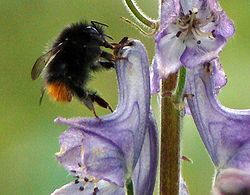Bombus wurflenii
Species of bee From Wikipedia, the free encyclopedia
Bombus wurflenii is a species of bumblebee found in several parts of central and northern Europe to Turkey and the Crimea peninsula in the southeast.[3][4]
| Bombus wurflenii | |
|---|---|
 | |
| Scientific classification | |
| Domain: | Eukaryota |
| Kingdom: | Animalia |
| Phylum: | Arthropoda |
| Class: | Insecta |
| Order: | Hymenoptera |
| Family: | Apidae |
| Genus: | Bombus |
| Subgenus: | Alpigenobombus |
| Species: | B. wurflenii |
| Binomial name | |
| Bombus wurflenii Radoszkowski, 1860[1] | |
| Synonyms | |
| |
Description
This bumblebee has a very short proboscis (tongue), powerful, toothed mandibles, and a short head. The queen has a body length of 19 to 22 mm (0.75 to 0.87 in), a wing span of 36 to 41 mm (1.4 to 1.6 in) and a black, shaggy fur with the three last terga (abdominal segments). The workers, which have body lengths ranging from 13 to 16 mm (0.51 to 0.63 in) and wing spans from 25 to 32 mm (0.98 to 1.26 in), look like the queen, except for the lesser length. The males are 14 to 16 mm (0.55 to 0.63 in) in length, have a wing span from 28 to 32 mm (1.1 to 1.3 in) and are otherwise similar to the females.[4][5] A lighter form, with most of thorax and the two anterior terga covered in pale fur exists.[4]
Ecology
The species is mainly found in mountainous areas.[3] In the Balkans, it is found from 1,300 to 2,100 m (4,300 to 6,900 ft) above sea level,[6] and in Turkey between 1,600 metres (5,200 ft) and 2,600 metres (8,500 ft).[4] The nest is small, containing 80 to 150 individuals.[5]
The bumblebee predominantly forages on flowers such as Vaccinium, Lamiaceae, Scrophulariaceae and Fabaceae.[4] According to Goulson, this species is an opportunistic nectar robber. The bees cut a hole into the back of the flower to access nectar, and so they do not participate in pollination.[7]
Distribution
In Europe, it can be found in Austria, Belgium, the Czech Republic, France, Germany, Hungary, Italy, Norway, Poland, Romania, Slovakia, Slovenia, Spain, Switzerland,[8] Scandinavia, the Ural and Caucasus in Russia,[3] northern Turkey, and the Crimean Peninsula.[4] It is absent from the British Isles, and its presence in Finland is disputed.[3]
References
Wikiwand - on
Seamless Wikipedia browsing. On steroids.

